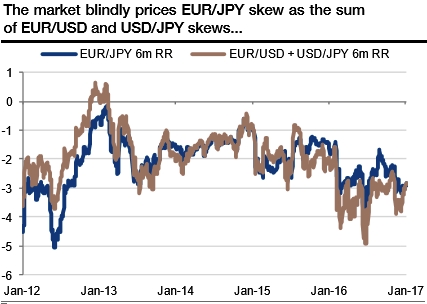The volatility smile most often signifies that traders are willing to pay higher implied volatility prices as the strike price grows aggressively out of the money.
Among G3 FX volatility space, EURJPY 3m-6m risk reversal is one of the highest compared with ATM volatility of the peer group, suggesting euro calls that sell topside skew.
The EURJPY volatility surface is offering very attractive opportunities because the skew on the 6m and 1y is currently excessive (refer above graph).
Is EURJPY IV skew mispricing? If we consider that the options market is pricing EURJPY risk reversals (RR) as the sum of EURUSD and USDJPY RR, the triangle is perfectly priced.
The implied volatility of 6m and 1y 25-delta strikes is trading about 3 volatility points higher than ATM volatility, which supposes that the implied volatility should be strongly negatively correlated with the FX rate.
Since 2013, the EURJPY RR has strongly mean reverted towards the vol/spot correlation. However, this correlation has been about zero for a few weeks, such that EURJPY 6m skew is now disconnected from its fair value.
Splitting the EURJPY RR into EURUSD and USDJPY components, like the market, exhibits the source of this mispricing. The EURUSD 6m RR is trading at -1.8 and the USDJPY at -1.1. The former is consistent with the EURUSD price action, which actually saw downside volatility.
However, USDJPY has indeed been positively correlated with its volatility, hence the EURJPY mispricing comes from the yen side. Investors could directly consider selling the USDJPY excessive skew, but we recommend selling the EURJPY skew instead. It offers a larger risk premium (due to the fairly priced EURUSD smile component), which is opportunistic given our bullish bias on the spot.



 Germany decriminalised cannabis: why the UK should consider doing the same
Germany decriminalised cannabis: why the UK should consider doing the same  How hybrid work is reinventing management
How hybrid work is reinventing management  What if whales took us to court? A move to grant them legal personhood would include the right to sue
What if whales took us to court? A move to grant them legal personhood would include the right to sue  An education in music makes you a better employee. Are recruiters in tune?
An education in music makes you a better employee. Are recruiters in tune?  FxWirePro- Gold Daily Outlook
FxWirePro- Gold Daily Outlook  Traditional Japanese diet associated with less brain shrinkage in women compared to western diet, says research
Traditional Japanese diet associated with less brain shrinkage in women compared to western diet, says research  FxWirePro- Gold Dailty Outlook
FxWirePro- Gold Dailty Outlook  In a time of information overload, enigmatic philosopher Byung-Chul Han seeks the re-enchantment of the world
In a time of information overload, enigmatic philosopher Byung-Chul Han seeks the re-enchantment of the world  Why Africa can be the beating heart of South Korea’s technology industry
Why Africa can be the beating heart of South Korea’s technology industry  Back to Black: Amy Winehouse biopic reviewed by an alcohol expert
Back to Black: Amy Winehouse biopic reviewed by an alcohol expert 































